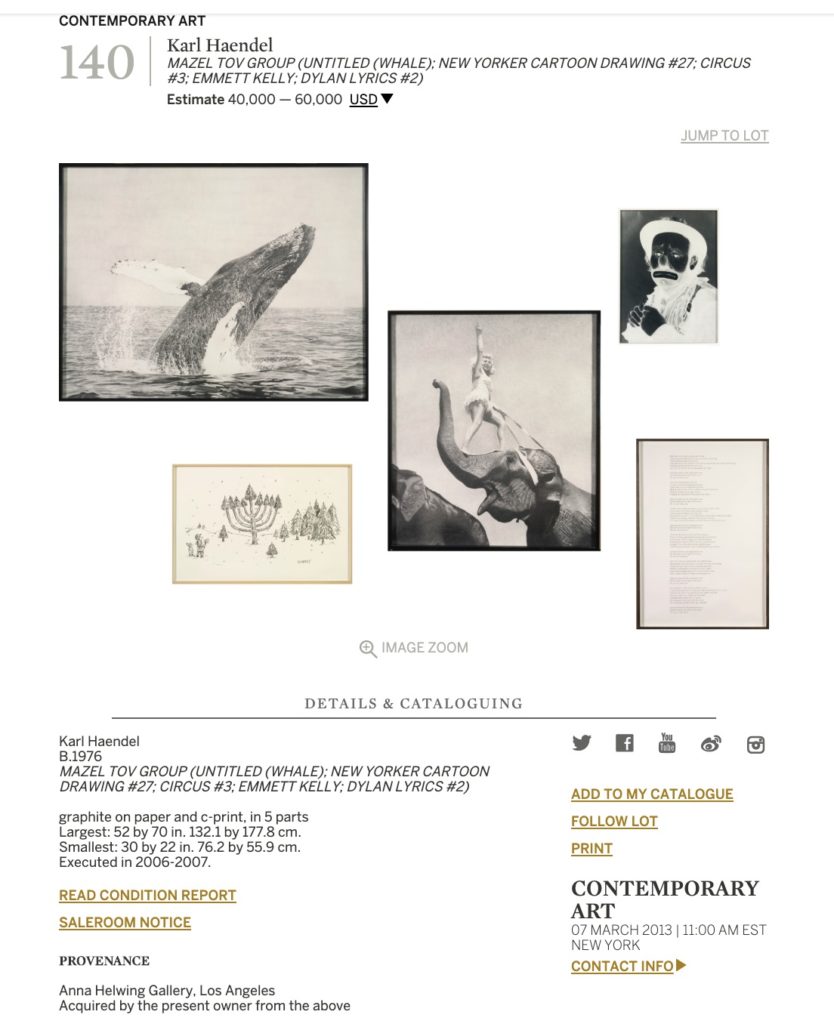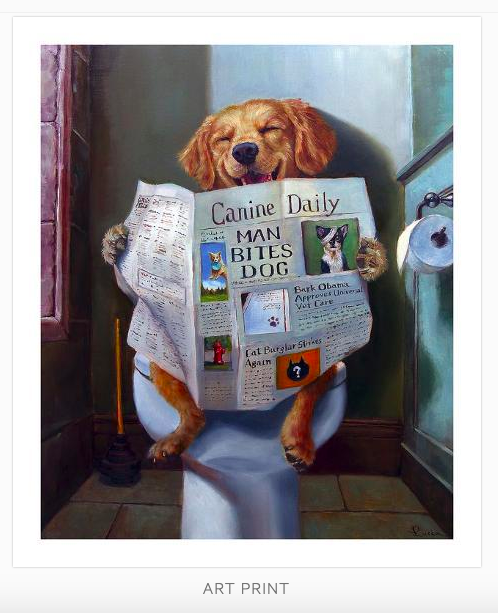Opinion
Why a New Yorker Cartoonist Is Up in Arms About Appropriation Art + Another Illuminating Idea From Around the Web
Plus, America's most popular picture is of a dog on a toilet.
![Karl Haendel. Mazel Tov Group (Untitled [Whale]; New Yorker Cartoon Drawing #27; Circus #3; Emmett Kelly; Dylan Lyrics #2) (in 5 parts) (2006–07), with the image from David Sipress circled. Karl Haendel. Mazel Tov Group (Untitled [Whale]; New Yorker Cartoon Drawing #27; Circus #3; Emmett Kelly; Dylan Lyrics #2) (in 5 parts) (2006–07), with the image from David Sipress circled.](https://news.artnet.com/app/news-upload/2020/02/karl-haendel-mazel-tov-group-sothebys-sipress-highlighted-1024x666.jpg)
Plus, America's most popular picture is of a dog on a toilet.
![Karl Haendel. Mazel Tov Group (Untitled [Whale]; New Yorker Cartoon Drawing #27; Circus #3; Emmett Kelly; Dylan Lyrics #2) (in 5 parts) (2006–07), with the image from David Sipress circled. Karl Haendel. Mazel Tov Group (Untitled [Whale]; New Yorker Cartoon Drawing #27; Circus #3; Emmett Kelly; Dylan Lyrics #2) (in 5 parts) (2006–07), with the image from David Sipress circled.](https://news.artnet.com/app/news-upload/2020/02/karl-haendel-mazel-tov-group-sothebys-sipress-highlighted-1024x666.jpg)
Ben Davis

Every week, we scan the media for interesting conversations about art. This week: thoughts on the changing meaning of “appropriation art” and the unexpected riddle about America’s most-purchased picture.
Ace New Yorker cartoonist David Sipress has a bone to pick with Karl Haendel.
Or, really, he thinks Haendel has picked a bone from him: Sipress is dismayed to discover that the LA-based artist has appropriated whole a Sipress New Yorker cartoon—or rather, Haendel made an exact drawing of it, signature and all, and incorporated it into a larger installation describing Sipress’s image as “a Jewish-American themed cartoon from the New Yorker.”
(Haendel’s installation, called Mazel Tov Group, was on view at the Henry Art Gallery last year; a friend emailed word of the borrowing to Sipress.)
I happen to like Haendel’s constellations of graphite images, which have a puzzle-like, seductively aerated quality. Sipress’s article is good to read though, partly because it is about the viscerally personal nature of the reaction to being appropriated—he’s intellectually at least OK with “appropriation art,” it just feels wrong: “I found that no amount of understanding of the theory behind the work could diminish how much it irritated me. On a simple, human level, I wuz robbed.” And so the cartoonist responds in a correspondingly personal way: with mockery and also more cartoons.
Here’s Sipress’s conclusion about the affair (or actually his final word is a cartoon; this is what comes right before):
In my research for this essay, I came across an auction estimate for the “Mazel Tov Group” of between forty thousand and sixty thousand dollars. Yikes! My original drawing of the “Jewish-American themed cartoon from The New Yorker” was bought a few years ago, for a tiny fraction of that estimate. But, then again, it was only the real thing. I’ll get over it. One friend tells me that I should be “flattered” to be used in this fashion. Obviously, I’m not there yet.
It’s an obvious point, but one not made enough: you can’t overstate the extent to which money affects the sense of what gets considered fair, on the gut level. If we were talking about somebody just making collages from old New Yorkers in their basement, the gut reaction probably wouldn’t be “I wuz robbed.” I think the deep irritation of Sipress is also a reflection of the relative value attached to different kinds of artforms in the popular imagination—a balance that has actually shifted in the recent past.

A screenshot of a Sotheby’s lot featuring an estimate for Karl Haendel’s Mazel Tov Group, cited by David Sipress.
In the last decade, there has been a dramatic shift in how images circulate. For all of the ‘90s and most of the ‘00s, “free culture” was viewed not just as a nice thing, but almost as a political cause to champion against Big Media’s monopoly on culture—and the rhetoric around “appropriation art” has always played off of that background, suggesting it was all about hijacking images from big media and dominant culture to give them fresh, critical meanings. Sometime in the 2010s, however, with the total commercialization of the web and the centralization of its profits in a few internet companies, “free culture” has come to be seen more and more as another way to destroy the livelihood of anyone who makes a living off anything that could be easily copied: journalism, photography, music, etc. Meanwhile, art became more and more culturally associated with big money and investment, and less with brainy criticality.
It can’t be stressed enough that the idea that the average artist has some huge reservoir of economic power to draw on is an optical illusion. That big price for Karl Haendel’s art at Sotheby’s that gets Sipress so worked up was just an estimate, not a realized sale. I looked up the actual auction. Mazel Tov Group was actually bought in back in 2013; it didn’t sell. Art remains as much of a crap-shoot as ever, and maybe even more so as its market becomes more speculative and fickle.
Nevertheless, the background signals of the economy shape the associations people make and how the conversation unfolds. Paradoxically, “appropriation” in art probably now sounds less provocatively radical (because everyone on the internet is copying and pasting images all the time), while at the same time certain defenses of “appropriation” are going to sound more and more like opportunistic justifications about how culture should be free (for tech platforms to profit off of). Intellectually, the case for appropriation is easier and easier to make, even as emotionally it acquires new gut-level negative associations.
I don’t personally think it’s necessarily a zero-sum game. I think it possible that Sipress’s original cartoons and reputation grow in value by becoming mixed and mashed up as a reference in art, gaining new levels of meaning and thus new value to new audiences (very much including whatever new audiences now take it as a reference because of this micro-controversy). But I do think it’s worth wondering whether artists, critics, and curators need some new ways to talk about appropriation art, given the changing place of both art and appropriation in the image economy.

Screenshot of Lucia Heffernan’s Dog Gone Funny on Art.com.
I have seen America’s favorite picture. It is Dog Gone Funny.
This comes courtesy of the latest copy of the Art.com magazine, the free mailer from the Walmart-owned art prints site (whose motto, for reasons that puzzle me, is “More Inspiration, Less Math”). Flipping through it, as I do every month, I come upon its list of most-popular prints. Number two, for reference, is Mark Rothko’s Untitled (Violet, Black, Orange, Yellow on White and Red) from 1949, licensed from the Guggenheim collection.
But sitting pretty atop the list is this painting, by Utah artist Lucia Heffernan, of a cackling Golden Retriever reading the newspaper whilst on the commode.
I refrain from commenting on the whole list, though it’s worth noting that “colorful abstraction” and “funny animal” are the winning formulas on Art.com.
Let us simply pause to pay homage to Dog Gone Funny, though. Heffernan specializes in humanized animals of a goofy—and sometimes slightly odd, more-adult-than-you-would expect—variety. (50 Scents of Grey features a dog reading a smutty book of the same title, with a canine butt on the cover that reads, “Scratch and Sniff.”)
In Dog Gone Funny, she has clearly tapped straight into America’s aesthetic main nerve, combining toilet humor and anthropomorphic animals. It is a masterpiece of post-Dogs Playing Poker figuration.
Like the legendary Dogs Playing Poker, though, there are unexpected layers. Would you believe me if I told you that Dog Gone Funny contains a political riddle for our time?
Our protagonist is reading his hometown newspaper, the Canine Daily. We cannot see what is amusing the dog so much. The headline is “MAN BITES DOG.” Below the fold, the story is “Cat Burglar Strikes Again.” There is also a picture of a fire hydrant, another little spritz of pee humor.

Lucia Heffernan, Dog Gone Funny (detail) from Art.com.
But the second story down is “Bark Obama Approves Universal Vet Care,” accompanied by a picture of a paw print of the canine president signing the bill. It’s actually positioned below a photo of a terrier with a bandaged eye, which seems to also go with “MAN BITES DOG,” so it could be that this momentous act of free veterinary care was triggered by a galvanizing act of unexpected, news-making, human-on-dog aggression.
What, I wonder, does America think when it sits on the toilet every day and contemplates the Canine Daily? (And that’s definitely where people are looking at this work; if you have a friend who has Dog Gone Funny in their den or bedroom, have a talk with them.)
Don’t get me wrong, I know that America mainly doesn’t think too hard about this picture. But it’s not like the headline is “Dogald J. Trump Builds Anti-Cat Wall.” It’s some kind of specific-ish reference that’s floating there.
I mean, the human-world Affordable Care Act wasn’t really universal healthcare, and its gains have been slowly strangled and undercut. But our dog friend is laughing; the vibes are positive. Why is this America’s art in 2020?
Is it nostalgia for an alternate, optimistic world—before the Trump times? Is it some kind of unprocessed suburban misconception that Obama “solved healthcare”? Or does it filter some ambient popular idea that actual universal healthcare is just a fundamentally positive thing—like a happy dog, perhaps?
Healthcare is the hottest political issue of the day. For whom does the dog laugh?